Audit Assurance and Compliance
VerifiedAdded on 2023/01/06
|13
|4540
|64
AI Summary
This report discusses the case of Cam & Bear Pty Ltd v McGoldrick [2018] NSWCA 110, which involves a breach of duty by the auditor. It explores the responsibilities of auditors in preparing accurate financial statements and the consequences of non-compliance. The case highlights the importance of auditors performing their duties with due care and diligence to avoid financial losses for stakeholders.
Contribute Materials
Your contribution can guide someone’s learning journey. Share your
documents today.

AUDIT ASSURANCE AND
COMPLIANCE
COMPLIANCE
Secure Best Marks with AI Grader
Need help grading? Try our AI Grader for instant feedback on your assignments.
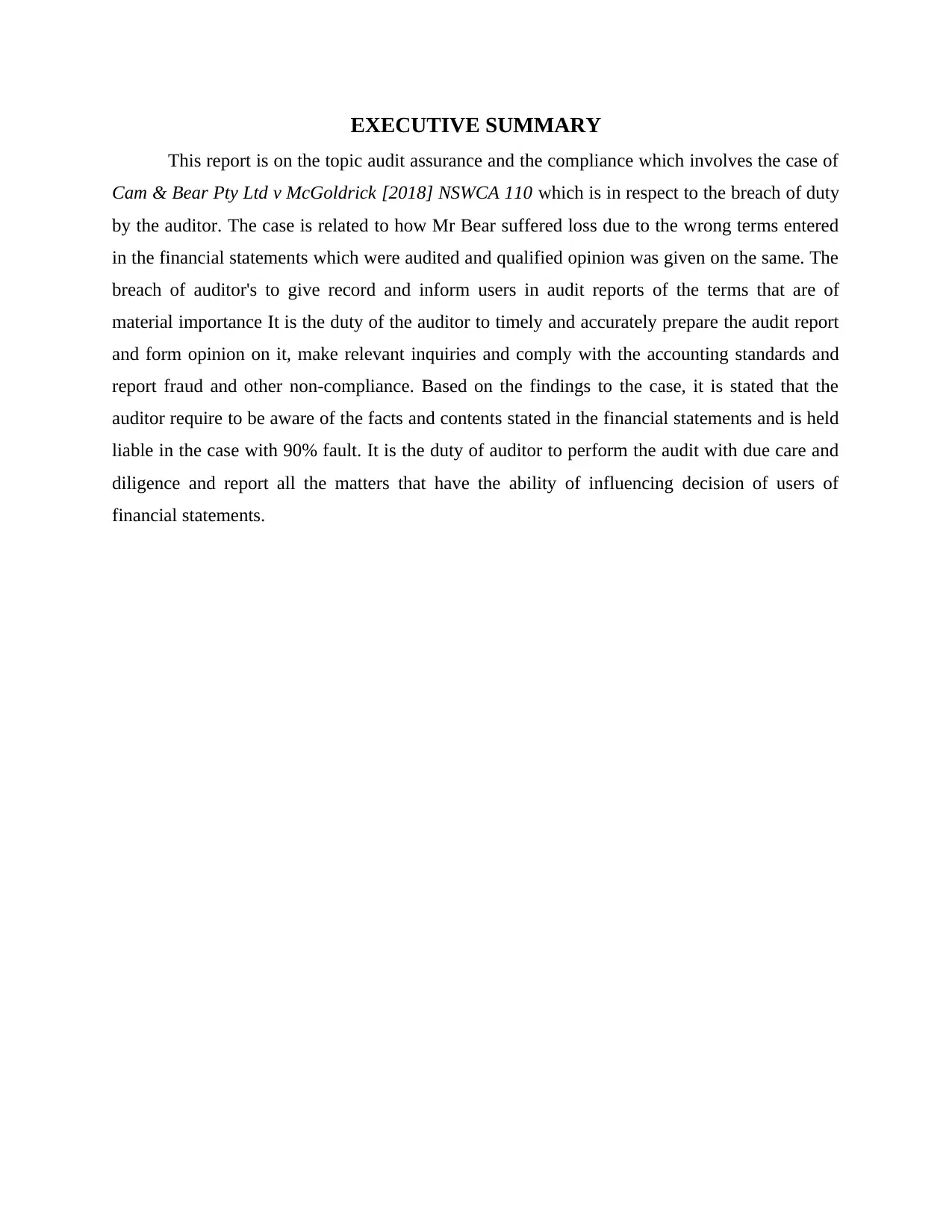
EXECUTIVE SUMMARY
This report is on the topic audit assurance and the compliance which involves the case of
Cam & Bear Pty Ltd v McGoldrick [2018] NSWCA 110 which is in respect to the breach of duty
by the auditor. The case is related to how Mr Bear suffered loss due to the wrong terms entered
in the financial statements which were audited and qualified opinion was given on the same. The
breach of auditor's to give record and inform users in audit reports of the terms that are of
material importance It is the duty of the auditor to timely and accurately prepare the audit report
and form opinion on it, make relevant inquiries and comply with the accounting standards and
report fraud and other non-compliance. Based on the findings to the case, it is stated that the
auditor require to be aware of the facts and contents stated in the financial statements and is held
liable in the case with 90% fault. It is the duty of auditor to perform the audit with due care and
diligence and report all the matters that have the ability of influencing decision of users of
financial statements.
This report is on the topic audit assurance and the compliance which involves the case of
Cam & Bear Pty Ltd v McGoldrick [2018] NSWCA 110 which is in respect to the breach of duty
by the auditor. The case is related to how Mr Bear suffered loss due to the wrong terms entered
in the financial statements which were audited and qualified opinion was given on the same. The
breach of auditor's to give record and inform users in audit reports of the terms that are of
material importance It is the duty of the auditor to timely and accurately prepare the audit report
and form opinion on it, make relevant inquiries and comply with the accounting standards and
report fraud and other non-compliance. Based on the findings to the case, it is stated that the
auditor require to be aware of the facts and contents stated in the financial statements and is held
liable in the case with 90% fault. It is the duty of auditor to perform the audit with due care and
diligence and report all the matters that have the ability of influencing decision of users of
financial statements.

TABLE OF CONTENTS
EXECUTIVE SUMMARY.............................................................................................................2
1. INTRODUCTION ......................................................................................................................1
2. Description of key events and factual issues...............................................................................1
3.Responsible parties. .....................................................................................................................2
4. Investigation and explanation .....................................................................................................2
5. Root cause of Issue......................................................................................................................3
6. Problems, mistakes or misrepresentations ..................................................................................4
7. Recommendations .......................................................................................................................6
1 Audit Strategy...........................................................................................................................6
2 Audit Program ..........................................................................................................................6
3 Other effective measures ..........................................................................................................7
CONCLUSION................................................................................................................................9
REFERENCES..............................................................................................................................10
EXECUTIVE SUMMARY.............................................................................................................2
1. INTRODUCTION ......................................................................................................................1
2. Description of key events and factual issues...............................................................................1
3.Responsible parties. .....................................................................................................................2
4. Investigation and explanation .....................................................................................................2
5. Root cause of Issue......................................................................................................................3
6. Problems, mistakes or misrepresentations ..................................................................................4
7. Recommendations .......................................................................................................................6
1 Audit Strategy...........................................................................................................................6
2 Audit Program ..........................................................................................................................6
3 Other effective measures ..........................................................................................................7
CONCLUSION................................................................................................................................9
REFERENCES..............................................................................................................................10
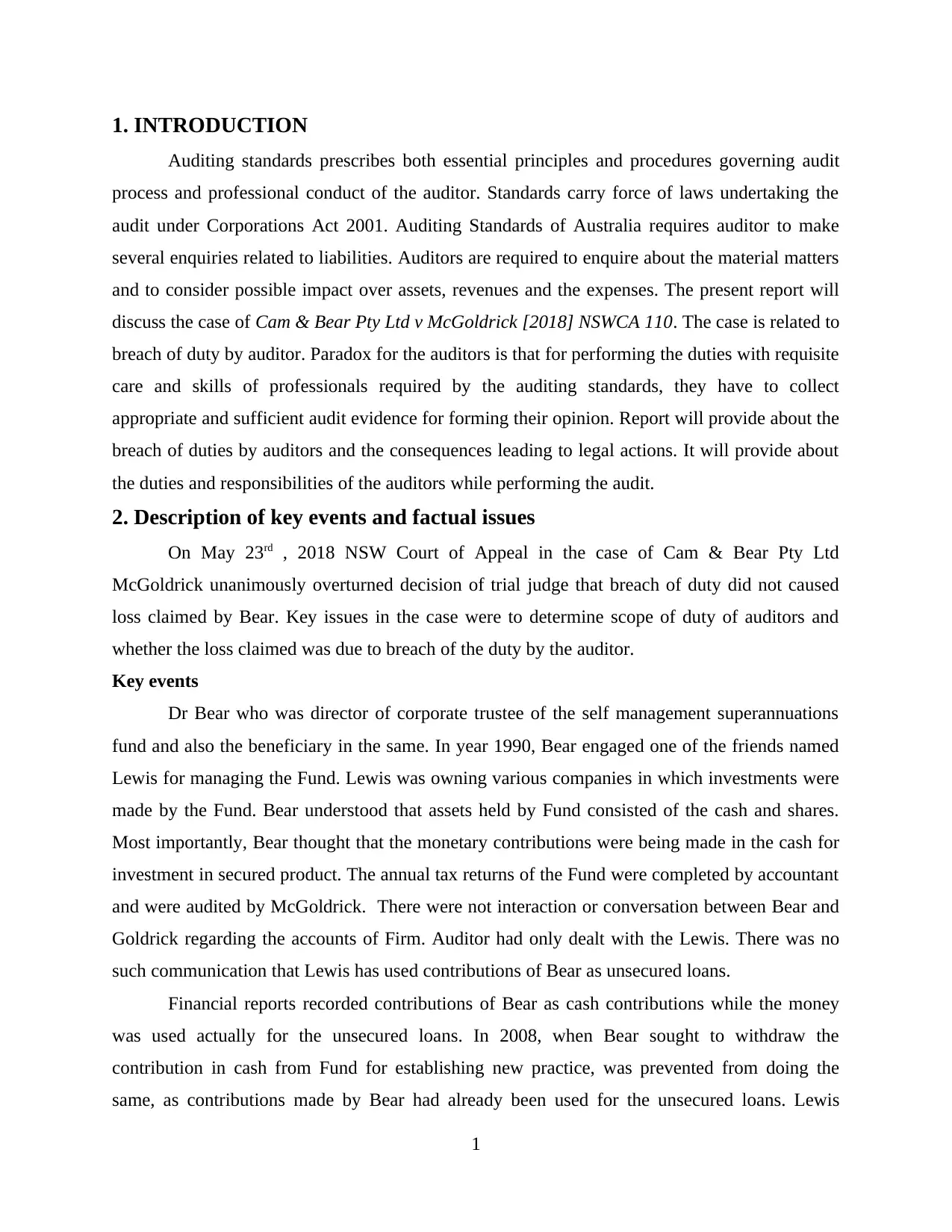
1. INTRODUCTION
Auditing standards prescribes both essential principles and procedures governing audit
process and professional conduct of the auditor. Standards carry force of laws undertaking the
audit under Corporations Act 2001. Auditing Standards of Australia requires auditor to make
several enquiries related to liabilities. Auditors are required to enquire about the material matters
and to consider possible impact over assets, revenues and the expenses. The present report will
discuss the case of Cam & Bear Pty Ltd v McGoldrick [2018] NSWCA 110. The case is related to
breach of duty by auditor. Paradox for the auditors is that for performing the duties with requisite
care and skills of professionals required by the auditing standards, they have to collect
appropriate and sufficient audit evidence for forming their opinion. Report will provide about the
breach of duties by auditors and the consequences leading to legal actions. It will provide about
the duties and responsibilities of the auditors while performing the audit.
2. Description of key events and factual issues
On May 23rd , 2018 NSW Court of Appeal in the case of Cam & Bear Pty Ltd
McGoldrick unanimously overturned decision of trial judge that breach of duty did not caused
loss claimed by Bear. Key issues in the case were to determine scope of duty of auditors and
whether the loss claimed was due to breach of the duty by the auditor.
Key events
Dr Bear who was director of corporate trustee of the self management superannuations
fund and also the beneficiary in the same. In year 1990, Bear engaged one of the friends named
Lewis for managing the Fund. Lewis was owning various companies in which investments were
made by the Fund. Bear understood that assets held by Fund consisted of the cash and shares.
Most importantly, Bear thought that the monetary contributions were being made in the cash for
investment in secured product. The annual tax returns of the Fund were completed by accountant
and were audited by McGoldrick. There were not interaction or conversation between Bear and
Goldrick regarding the accounts of Firm. Auditor had only dealt with the Lewis. There was no
such communication that Lewis has used contributions of Bear as unsecured loans.
Financial reports recorded contributions of Bear as cash contributions while the money
was used actually for the unsecured loans. In 2008, when Bear sought to withdraw the
contribution in cash from Fund for establishing new practice, was prevented from doing the
same, as contributions made by Bear had already been used for the unsecured loans. Lewis
1
Auditing standards prescribes both essential principles and procedures governing audit
process and professional conduct of the auditor. Standards carry force of laws undertaking the
audit under Corporations Act 2001. Auditing Standards of Australia requires auditor to make
several enquiries related to liabilities. Auditors are required to enquire about the material matters
and to consider possible impact over assets, revenues and the expenses. The present report will
discuss the case of Cam & Bear Pty Ltd v McGoldrick [2018] NSWCA 110. The case is related to
breach of duty by auditor. Paradox for the auditors is that for performing the duties with requisite
care and skills of professionals required by the auditing standards, they have to collect
appropriate and sufficient audit evidence for forming their opinion. Report will provide about the
breach of duties by auditors and the consequences leading to legal actions. It will provide about
the duties and responsibilities of the auditors while performing the audit.
2. Description of key events and factual issues
On May 23rd , 2018 NSW Court of Appeal in the case of Cam & Bear Pty Ltd
McGoldrick unanimously overturned decision of trial judge that breach of duty did not caused
loss claimed by Bear. Key issues in the case were to determine scope of duty of auditors and
whether the loss claimed was due to breach of the duty by the auditor.
Key events
Dr Bear who was director of corporate trustee of the self management superannuations
fund and also the beneficiary in the same. In year 1990, Bear engaged one of the friends named
Lewis for managing the Fund. Lewis was owning various companies in which investments were
made by the Fund. Bear understood that assets held by Fund consisted of the cash and shares.
Most importantly, Bear thought that the monetary contributions were being made in the cash for
investment in secured product. The annual tax returns of the Fund were completed by accountant
and were audited by McGoldrick. There were not interaction or conversation between Bear and
Goldrick regarding the accounts of Firm. Auditor had only dealt with the Lewis. There was no
such communication that Lewis has used contributions of Bear as unsecured loans.
Financial reports recorded contributions of Bear as cash contributions while the money
was used actually for the unsecured loans. In 2008, when Bear sought to withdraw the
contribution in cash from Fund for establishing new practice, was prevented from doing the
same, as contributions made by Bear had already been used for the unsecured loans. Lewis
1
Secure Best Marks with AI Grader
Need help grading? Try our AI Grader for instant feedback on your assignments.
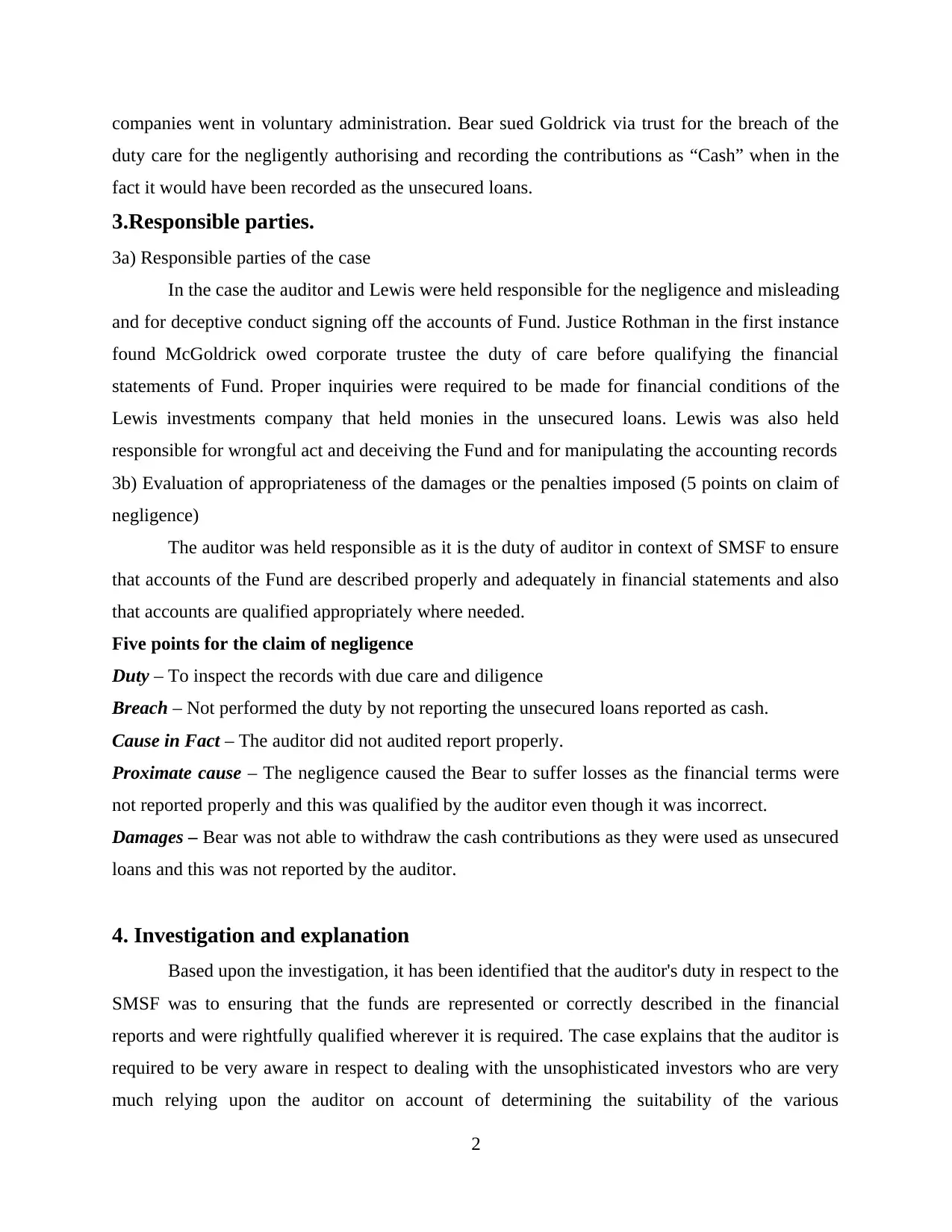
companies went in voluntary administration. Bear sued Goldrick via trust for the breach of the
duty care for the negligently authorising and recording the contributions as “Cash” when in the
fact it would have been recorded as the unsecured loans.
3.Responsible parties.
3a) Responsible parties of the case
In the case the auditor and Lewis were held responsible for the negligence and misleading
and for deceptive conduct signing off the accounts of Fund. Justice Rothman in the first instance
found McGoldrick owed corporate trustee the duty of care before qualifying the financial
statements of Fund. Proper inquiries were required to be made for financial conditions of the
Lewis investments company that held monies in the unsecured loans. Lewis was also held
responsible for wrongful act and deceiving the Fund and for manipulating the accounting records
3b) Evaluation of appropriateness of the damages or the penalties imposed (5 points on claim of
negligence)
The auditor was held responsible as it is the duty of auditor in context of SMSF to ensure
that accounts of the Fund are described properly and adequately in financial statements and also
that accounts are qualified appropriately where needed.
Five points for the claim of negligence
Duty – To inspect the records with due care and diligence
Breach – Not performed the duty by not reporting the unsecured loans reported as cash.
Cause in Fact – The auditor did not audited report properly.
Proximate cause – The negligence caused the Bear to suffer losses as the financial terms were
not reported properly and this was qualified by the auditor even though it was incorrect.
Damages – Bear was not able to withdraw the cash contributions as they were used as unsecured
loans and this was not reported by the auditor.
4. Investigation and explanation
Based upon the investigation, it has been identified that the auditor's duty in respect to the
SMSF was to ensuring that the funds are represented or correctly described in the financial
reports and were rightfully qualified wherever it is required. The case explains that the auditor is
required to be very aware in respect to dealing with the unsophisticated investors who are very
much relying upon the auditor on account of determining the suitability of the various
2
duty care for the negligently authorising and recording the contributions as “Cash” when in the
fact it would have been recorded as the unsecured loans.
3.Responsible parties.
3a) Responsible parties of the case
In the case the auditor and Lewis were held responsible for the negligence and misleading
and for deceptive conduct signing off the accounts of Fund. Justice Rothman in the first instance
found McGoldrick owed corporate trustee the duty of care before qualifying the financial
statements of Fund. Proper inquiries were required to be made for financial conditions of the
Lewis investments company that held monies in the unsecured loans. Lewis was also held
responsible for wrongful act and deceiving the Fund and for manipulating the accounting records
3b) Evaluation of appropriateness of the damages or the penalties imposed (5 points on claim of
negligence)
The auditor was held responsible as it is the duty of auditor in context of SMSF to ensure
that accounts of the Fund are described properly and adequately in financial statements and also
that accounts are qualified appropriately where needed.
Five points for the claim of negligence
Duty – To inspect the records with due care and diligence
Breach – Not performed the duty by not reporting the unsecured loans reported as cash.
Cause in Fact – The auditor did not audited report properly.
Proximate cause – The negligence caused the Bear to suffer losses as the financial terms were
not reported properly and this was qualified by the auditor even though it was incorrect.
Damages – Bear was not able to withdraw the cash contributions as they were used as unsecured
loans and this was not reported by the auditor.
4. Investigation and explanation
Based upon the investigation, it has been identified that the auditor's duty in respect to the
SMSF was to ensuring that the funds are represented or correctly described in the financial
reports and were rightfully qualified wherever it is required. The case explains that the auditor is
required to be very aware in respect to dealing with the unsophisticated investors who are very
much relying upon the auditor on account of determining the suitability of the various
2
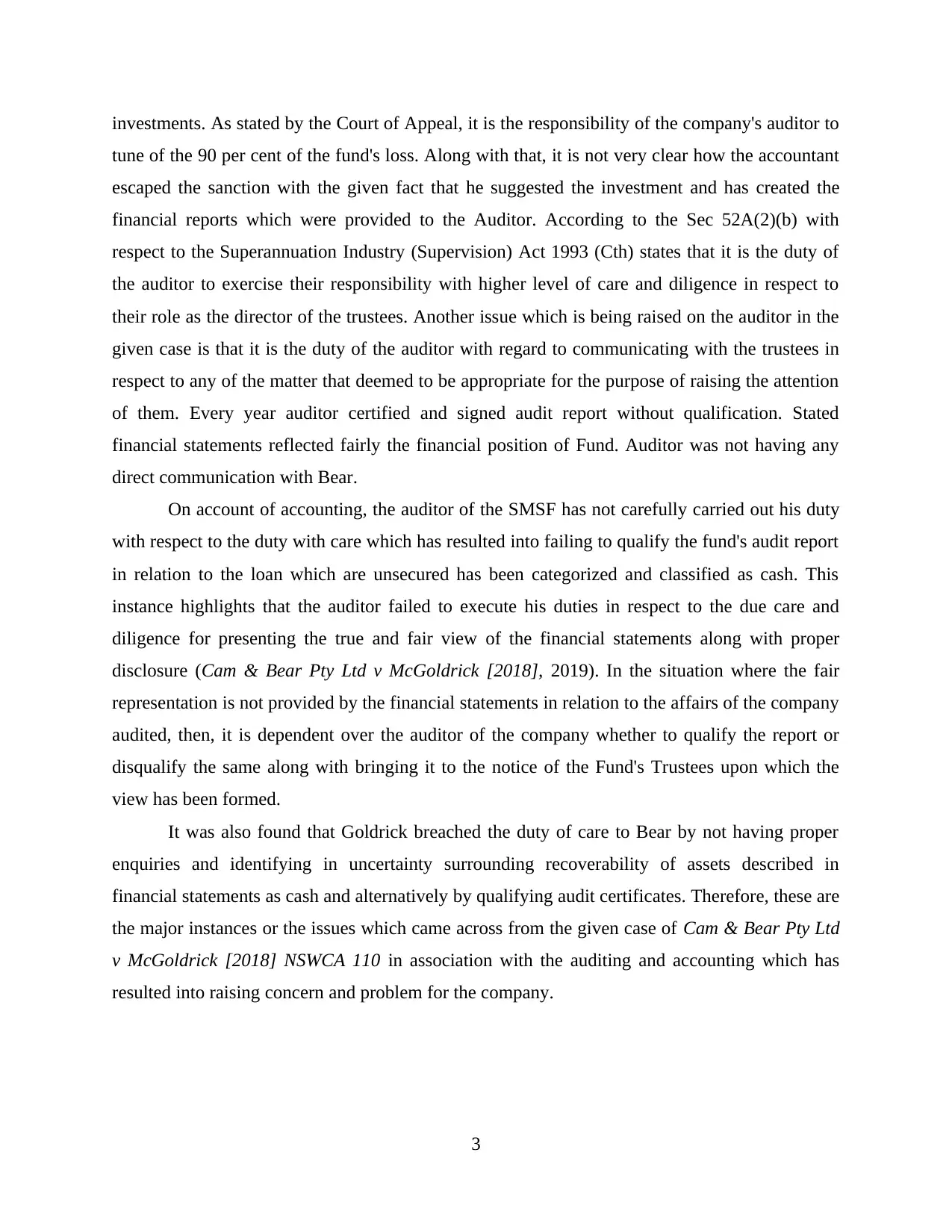
investments. As stated by the Court of Appeal, it is the responsibility of the company's auditor to
tune of the 90 per cent of the fund's loss. Along with that, it is not very clear how the accountant
escaped the sanction with the given fact that he suggested the investment and has created the
financial reports which were provided to the Auditor. According to the Sec 52A(2)(b) with
respect to the Superannuation Industry (Supervision) Act 1993 (Cth) states that it is the duty of
the auditor to exercise their responsibility with higher level of care and diligence in respect to
their role as the director of the trustees. Another issue which is being raised on the auditor in the
given case is that it is the duty of the auditor with regard to communicating with the trustees in
respect to any of the matter that deemed to be appropriate for the purpose of raising the attention
of them. Every year auditor certified and signed audit report without qualification. Stated
financial statements reflected fairly the financial position of Fund. Auditor was not having any
direct communication with Bear.
On account of accounting, the auditor of the SMSF has not carefully carried out his duty
with respect to the duty with care which has resulted into failing to qualify the fund's audit report
in relation to the loan which are unsecured has been categorized and classified as cash. This
instance highlights that the auditor failed to execute his duties in respect to the due care and
diligence for presenting the true and fair view of the financial statements along with proper
disclosure (Cam & Bear Pty Ltd v McGoldrick [2018], 2019). In the situation where the fair
representation is not provided by the financial statements in relation to the affairs of the company
audited, then, it is dependent over the auditor of the company whether to qualify the report or
disqualify the same along with bringing it to the notice of the Fund's Trustees upon which the
view has been formed.
It was also found that Goldrick breached the duty of care to Bear by not having proper
enquiries and identifying in uncertainty surrounding recoverability of assets described in
financial statements as cash and alternatively by qualifying audit certificates. Therefore, these are
the major instances or the issues which came across from the given case of Cam & Bear Pty Ltd
v McGoldrick [2018] NSWCA 110 in association with the auditing and accounting which has
resulted into raising concern and problem for the company.
3
tune of the 90 per cent of the fund's loss. Along with that, it is not very clear how the accountant
escaped the sanction with the given fact that he suggested the investment and has created the
financial reports which were provided to the Auditor. According to the Sec 52A(2)(b) with
respect to the Superannuation Industry (Supervision) Act 1993 (Cth) states that it is the duty of
the auditor to exercise their responsibility with higher level of care and diligence in respect to
their role as the director of the trustees. Another issue which is being raised on the auditor in the
given case is that it is the duty of the auditor with regard to communicating with the trustees in
respect to any of the matter that deemed to be appropriate for the purpose of raising the attention
of them. Every year auditor certified and signed audit report without qualification. Stated
financial statements reflected fairly the financial position of Fund. Auditor was not having any
direct communication with Bear.
On account of accounting, the auditor of the SMSF has not carefully carried out his duty
with respect to the duty with care which has resulted into failing to qualify the fund's audit report
in relation to the loan which are unsecured has been categorized and classified as cash. This
instance highlights that the auditor failed to execute his duties in respect to the due care and
diligence for presenting the true and fair view of the financial statements along with proper
disclosure (Cam & Bear Pty Ltd v McGoldrick [2018], 2019). In the situation where the fair
representation is not provided by the financial statements in relation to the affairs of the company
audited, then, it is dependent over the auditor of the company whether to qualify the report or
disqualify the same along with bringing it to the notice of the Fund's Trustees upon which the
view has been formed.
It was also found that Goldrick breached the duty of care to Bear by not having proper
enquiries and identifying in uncertainty surrounding recoverability of assets described in
financial statements as cash and alternatively by qualifying audit certificates. Therefore, these are
the major instances or the issues which came across from the given case of Cam & Bear Pty Ltd
v McGoldrick [2018] NSWCA 110 in association with the auditing and accounting which has
resulted into raising concern and problem for the company.
3
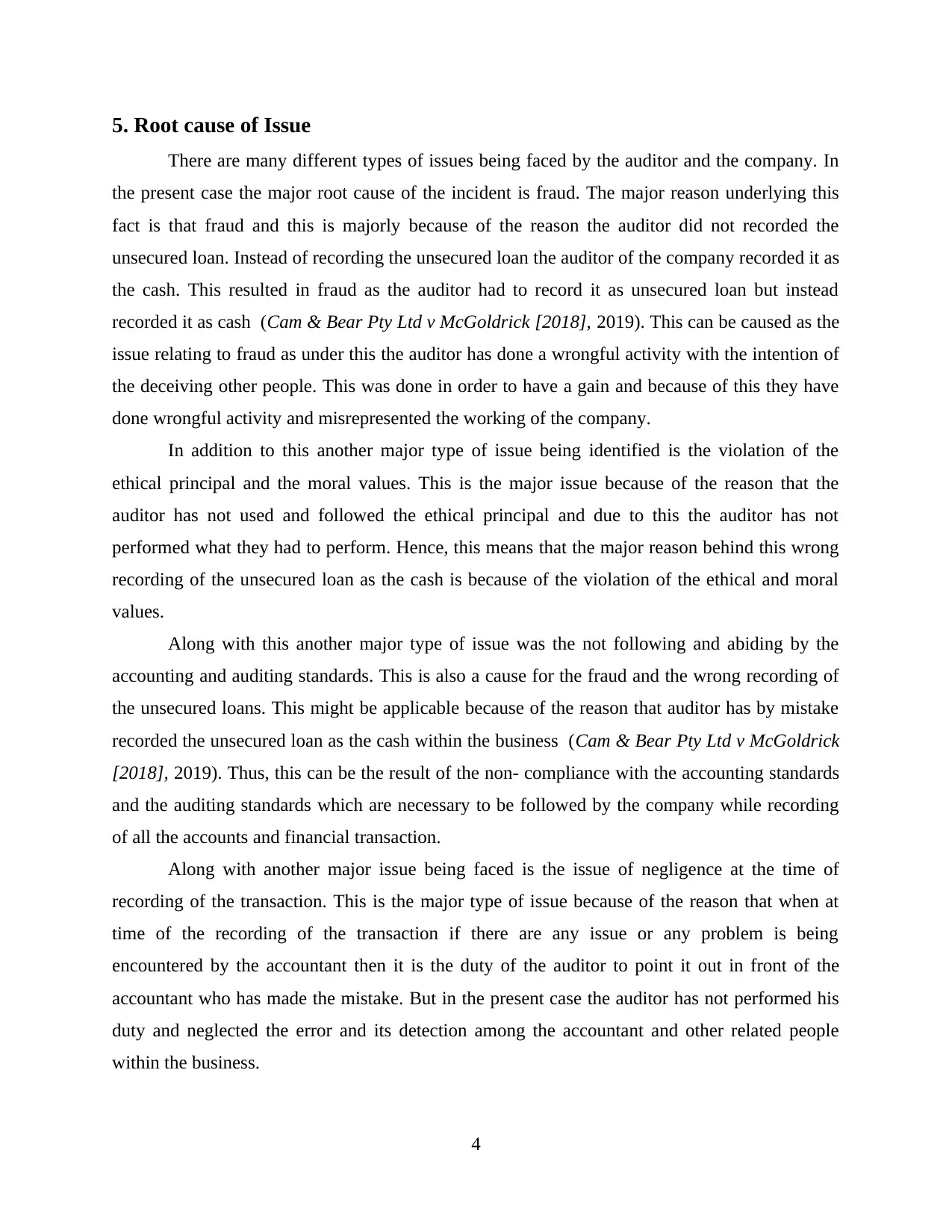
5. Root cause of Issue
There are many different types of issues being faced by the auditor and the company. In
the present case the major root cause of the incident is fraud. The major reason underlying this
fact is that fraud and this is majorly because of the reason the auditor did not recorded the
unsecured loan. Instead of recording the unsecured loan the auditor of the company recorded it as
the cash. This resulted in fraud as the auditor had to record it as unsecured loan but instead
recorded it as cash (Cam & Bear Pty Ltd v McGoldrick [2018], 2019). This can be caused as the
issue relating to fraud as under this the auditor has done a wrongful activity with the intention of
the deceiving other people. This was done in order to have a gain and because of this they have
done wrongful activity and misrepresented the working of the company.
In addition to this another major type of issue being identified is the violation of the
ethical principal and the moral values. This is the major issue because of the reason that the
auditor has not used and followed the ethical principal and due to this the auditor has not
performed what they had to perform. Hence, this means that the major reason behind this wrong
recording of the unsecured loan as the cash is because of the violation of the ethical and moral
values.
Along with this another major type of issue was the not following and abiding by the
accounting and auditing standards. This is also a cause for the fraud and the wrong recording of
the unsecured loans. This might be applicable because of the reason that auditor has by mistake
recorded the unsecured loan as the cash within the business (Cam & Bear Pty Ltd v McGoldrick
[2018], 2019). Thus, this can be the result of the non- compliance with the accounting standards
and the auditing standards which are necessary to be followed by the company while recording
of all the accounts and financial transaction.
Along with another major issue being faced is the issue of negligence at the time of
recording of the transaction. This is the major type of issue because of the reason that when at
time of the recording of the transaction if there are any issue or any problem is being
encountered by the accountant then it is the duty of the auditor to point it out in front of the
accountant who has made the mistake. But in the present case the auditor has not performed his
duty and neglected the error and its detection among the accountant and other related people
within the business.
4
There are many different types of issues being faced by the auditor and the company. In
the present case the major root cause of the incident is fraud. The major reason underlying this
fact is that fraud and this is majorly because of the reason the auditor did not recorded the
unsecured loan. Instead of recording the unsecured loan the auditor of the company recorded it as
the cash. This resulted in fraud as the auditor had to record it as unsecured loan but instead
recorded it as cash (Cam & Bear Pty Ltd v McGoldrick [2018], 2019). This can be caused as the
issue relating to fraud as under this the auditor has done a wrongful activity with the intention of
the deceiving other people. This was done in order to have a gain and because of this they have
done wrongful activity and misrepresented the working of the company.
In addition to this another major type of issue being identified is the violation of the
ethical principal and the moral values. This is the major issue because of the reason that the
auditor has not used and followed the ethical principal and due to this the auditor has not
performed what they had to perform. Hence, this means that the major reason behind this wrong
recording of the unsecured loan as the cash is because of the violation of the ethical and moral
values.
Along with this another major type of issue was the not following and abiding by the
accounting and auditing standards. This is also a cause for the fraud and the wrong recording of
the unsecured loans. This might be applicable because of the reason that auditor has by mistake
recorded the unsecured loan as the cash within the business (Cam & Bear Pty Ltd v McGoldrick
[2018], 2019). Thus, this can be the result of the non- compliance with the accounting standards
and the auditing standards which are necessary to be followed by the company while recording
of all the accounts and financial transaction.
Along with another major issue being faced is the issue of negligence at the time of
recording of the transaction. This is the major type of issue because of the reason that when at
time of the recording of the transaction if there are any issue or any problem is being
encountered by the accountant then it is the duty of the auditor to point it out in front of the
accountant who has made the mistake. But in the present case the auditor has not performed his
duty and neglected the error and its detection among the accountant and other related people
within the business.
4
Paraphrase This Document
Need a fresh take? Get an instant paraphrase of this document with our AI Paraphraser
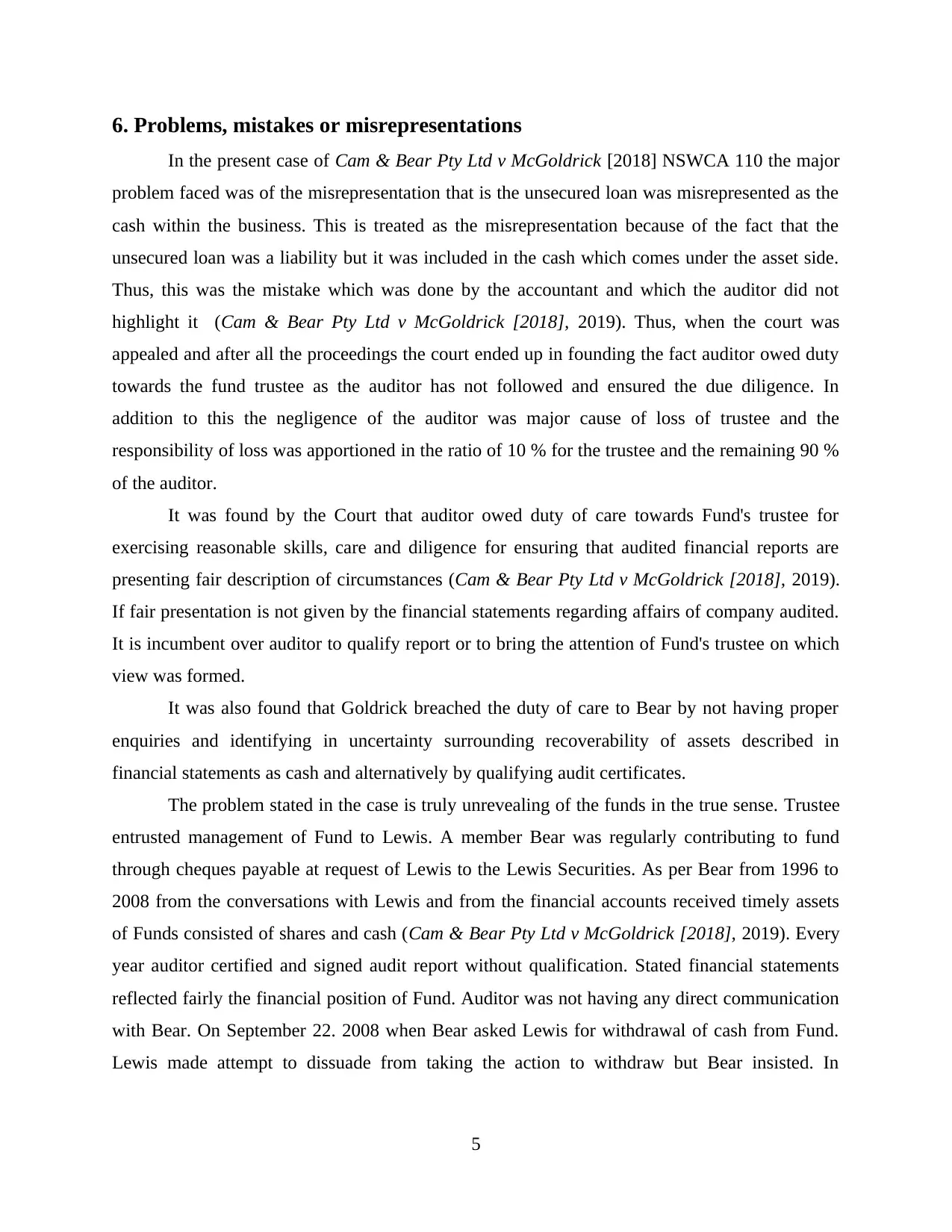
6. Problems, mistakes or misrepresentations
In the present case of Cam & Bear Pty Ltd v McGoldrick [2018] NSWCA 110 the major
problem faced was of the misrepresentation that is the unsecured loan was misrepresented as the
cash within the business. This is treated as the misrepresentation because of the fact that the
unsecured loan was a liability but it was included in the cash which comes under the asset side.
Thus, this was the mistake which was done by the accountant and which the auditor did not
highlight it (Cam & Bear Pty Ltd v McGoldrick [2018], 2019). Thus, when the court was
appealed and after all the proceedings the court ended up in founding the fact auditor owed duty
towards the fund trustee as the auditor has not followed and ensured the due diligence. In
addition to this the negligence of the auditor was major cause of loss of trustee and the
responsibility of loss was apportioned in the ratio of 10 % for the trustee and the remaining 90 %
of the auditor.
It was found by the Court that auditor owed duty of care towards Fund's trustee for
exercising reasonable skills, care and diligence for ensuring that audited financial reports are
presenting fair description of circumstances (Cam & Bear Pty Ltd v McGoldrick [2018], 2019).
If fair presentation is not given by the financial statements regarding affairs of company audited.
It is incumbent over auditor to qualify report or to bring the attention of Fund's trustee on which
view was formed.
It was also found that Goldrick breached the duty of care to Bear by not having proper
enquiries and identifying in uncertainty surrounding recoverability of assets described in
financial statements as cash and alternatively by qualifying audit certificates.
The problem stated in the case is truly unrevealing of the funds in the true sense. Trustee
entrusted management of Fund to Lewis. A member Bear was regularly contributing to fund
through cheques payable at request of Lewis to the Lewis Securities. As per Bear from 1996 to
2008 from the conversations with Lewis and from the financial accounts received timely assets
of Funds consisted of shares and cash (Cam & Bear Pty Ltd v McGoldrick [2018], 2019). Every
year auditor certified and signed audit report without qualification. Stated financial statements
reflected fairly the financial position of Fund. Auditor was not having any direct communication
with Bear. On September 22. 2008 when Bear asked Lewis for withdrawal of cash from Fund.
Lewis made attempt to dissuade from taking the action to withdraw but Bear insisted. In
5
In the present case of Cam & Bear Pty Ltd v McGoldrick [2018] NSWCA 110 the major
problem faced was of the misrepresentation that is the unsecured loan was misrepresented as the
cash within the business. This is treated as the misrepresentation because of the fact that the
unsecured loan was a liability but it was included in the cash which comes under the asset side.
Thus, this was the mistake which was done by the accountant and which the auditor did not
highlight it (Cam & Bear Pty Ltd v McGoldrick [2018], 2019). Thus, when the court was
appealed and after all the proceedings the court ended up in founding the fact auditor owed duty
towards the fund trustee as the auditor has not followed and ensured the due diligence. In
addition to this the negligence of the auditor was major cause of loss of trustee and the
responsibility of loss was apportioned in the ratio of 10 % for the trustee and the remaining 90 %
of the auditor.
It was found by the Court that auditor owed duty of care towards Fund's trustee for
exercising reasonable skills, care and diligence for ensuring that audited financial reports are
presenting fair description of circumstances (Cam & Bear Pty Ltd v McGoldrick [2018], 2019).
If fair presentation is not given by the financial statements regarding affairs of company audited.
It is incumbent over auditor to qualify report or to bring the attention of Fund's trustee on which
view was formed.
It was also found that Goldrick breached the duty of care to Bear by not having proper
enquiries and identifying in uncertainty surrounding recoverability of assets described in
financial statements as cash and alternatively by qualifying audit certificates.
The problem stated in the case is truly unrevealing of the funds in the true sense. Trustee
entrusted management of Fund to Lewis. A member Bear was regularly contributing to fund
through cheques payable at request of Lewis to the Lewis Securities. As per Bear from 1996 to
2008 from the conversations with Lewis and from the financial accounts received timely assets
of Funds consisted of shares and cash (Cam & Bear Pty Ltd v McGoldrick [2018], 2019). Every
year auditor certified and signed audit report without qualification. Stated financial statements
reflected fairly the financial position of Fund. Auditor was not having any direct communication
with Bear. On September 22. 2008 when Bear asked Lewis for withdrawal of cash from Fund.
Lewis made attempt to dissuade from taking the action to withdraw but Bear insisted. In
5
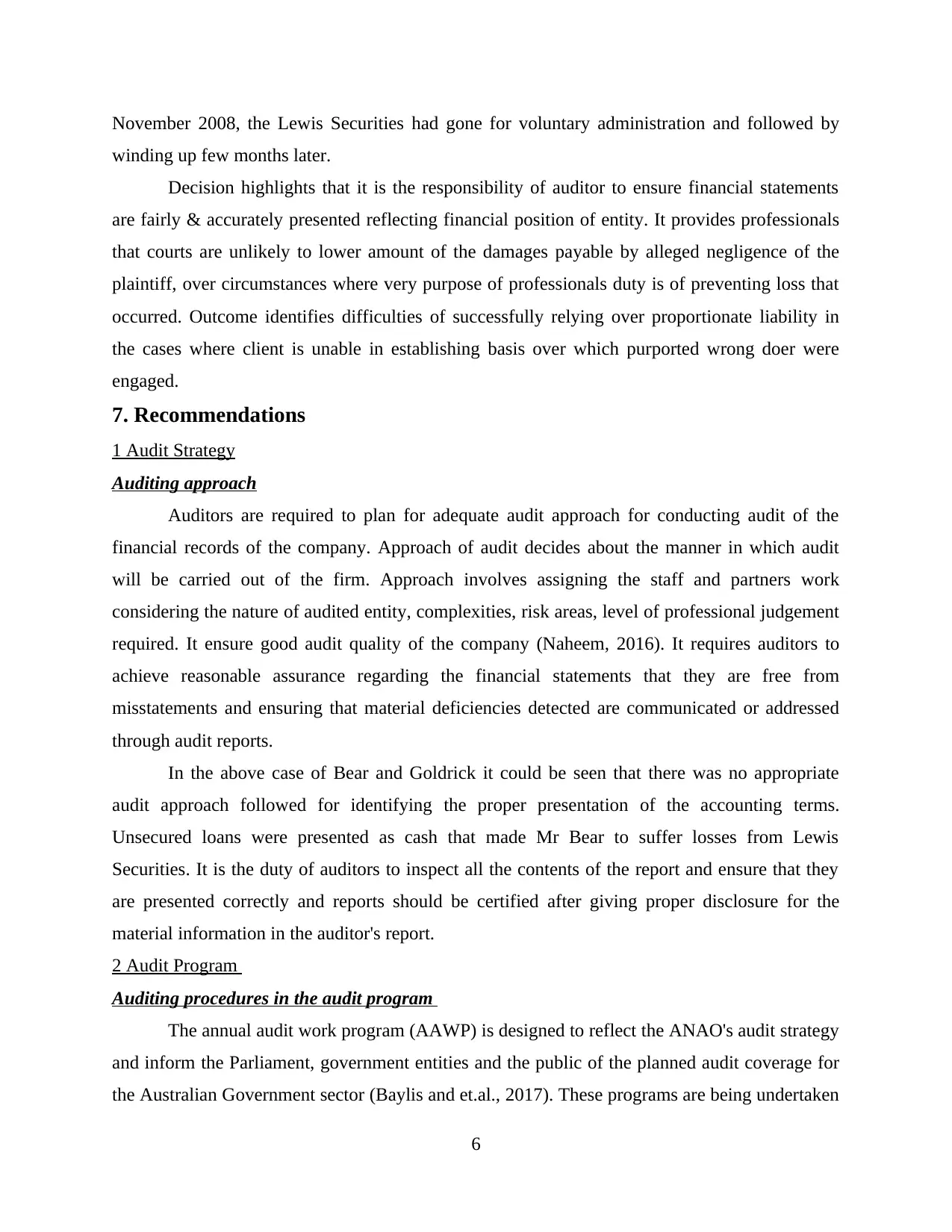
November 2008, the Lewis Securities had gone for voluntary administration and followed by
winding up few months later.
Decision highlights that it is the responsibility of auditor to ensure financial statements
are fairly & accurately presented reflecting financial position of entity. It provides professionals
that courts are unlikely to lower amount of the damages payable by alleged negligence of the
plaintiff, over circumstances where very purpose of professionals duty is of preventing loss that
occurred. Outcome identifies difficulties of successfully relying over proportionate liability in
the cases where client is unable in establishing basis over which purported wrong doer were
engaged.
7. Recommendations
1 Audit Strategy
Auditing approach
Auditors are required to plan for adequate audit approach for conducting audit of the
financial records of the company. Approach of audit decides about the manner in which audit
will be carried out of the firm. Approach involves assigning the staff and partners work
considering the nature of audited entity, complexities, risk areas, level of professional judgement
required. It ensure good audit quality of the company (Naheem, 2016). It requires auditors to
achieve reasonable assurance regarding the financial statements that they are free from
misstatements and ensuring that material deficiencies detected are communicated or addressed
through audit reports.
In the above case of Bear and Goldrick it could be seen that there was no appropriate
audit approach followed for identifying the proper presentation of the accounting terms.
Unsecured loans were presented as cash that made Mr Bear to suffer losses from Lewis
Securities. It is the duty of auditors to inspect all the contents of the report and ensure that they
are presented correctly and reports should be certified after giving proper disclosure for the
material information in the auditor's report.
2 Audit Program
Auditing procedures in the audit program
The annual audit work program (AAWP) is designed to reflect the ANAO's audit strategy
and inform the Parliament, government entities and the public of the planned audit coverage for
the Australian Government sector (Baylis and et.al., 2017). These programs are being undertaken
6
winding up few months later.
Decision highlights that it is the responsibility of auditor to ensure financial statements
are fairly & accurately presented reflecting financial position of entity. It provides professionals
that courts are unlikely to lower amount of the damages payable by alleged negligence of the
plaintiff, over circumstances where very purpose of professionals duty is of preventing loss that
occurred. Outcome identifies difficulties of successfully relying over proportionate liability in
the cases where client is unable in establishing basis over which purported wrong doer were
engaged.
7. Recommendations
1 Audit Strategy
Auditing approach
Auditors are required to plan for adequate audit approach for conducting audit of the
financial records of the company. Approach of audit decides about the manner in which audit
will be carried out of the firm. Approach involves assigning the staff and partners work
considering the nature of audited entity, complexities, risk areas, level of professional judgement
required. It ensure good audit quality of the company (Naheem, 2016). It requires auditors to
achieve reasonable assurance regarding the financial statements that they are free from
misstatements and ensuring that material deficiencies detected are communicated or addressed
through audit reports.
In the above case of Bear and Goldrick it could be seen that there was no appropriate
audit approach followed for identifying the proper presentation of the accounting terms.
Unsecured loans were presented as cash that made Mr Bear to suffer losses from Lewis
Securities. It is the duty of auditors to inspect all the contents of the report and ensure that they
are presented correctly and reports should be certified after giving proper disclosure for the
material information in the auditor's report.
2 Audit Program
Auditing procedures in the audit program
The annual audit work program (AAWP) is designed to reflect the ANAO's audit strategy
and inform the Parliament, government entities and the public of the planned audit coverage for
the Australian Government sector (Baylis and et.al., 2017). These programs are being undertaken
6
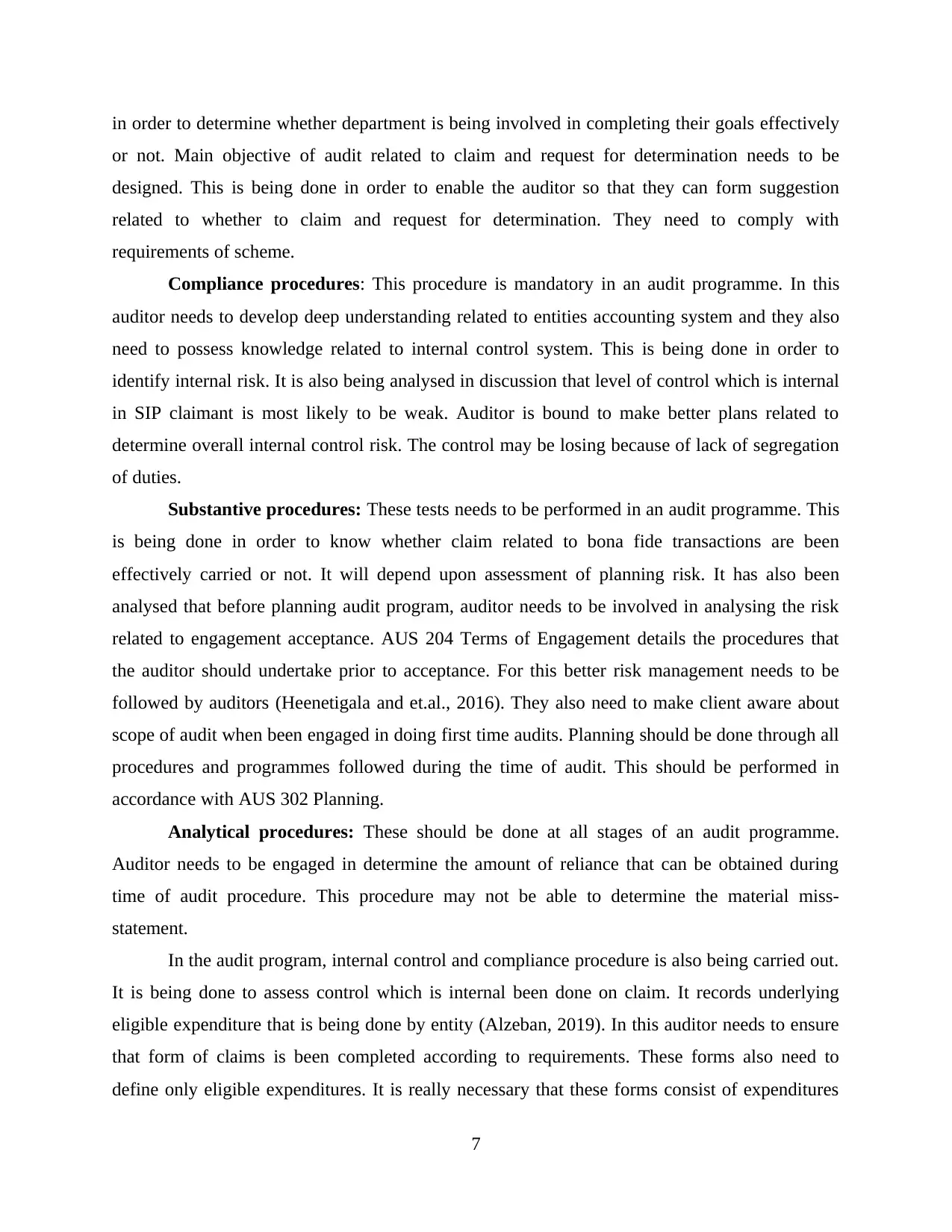
in order to determine whether department is being involved in completing their goals effectively
or not. Main objective of audit related to claim and request for determination needs to be
designed. This is being done in order to enable the auditor so that they can form suggestion
related to whether to claim and request for determination. They need to comply with
requirements of scheme.
Compliance procedures: This procedure is mandatory in an audit programme. In this
auditor needs to develop deep understanding related to entities accounting system and they also
need to possess knowledge related to internal control system. This is being done in order to
identify internal risk. It is also being analysed in discussion that level of control which is internal
in SIP claimant is most likely to be weak. Auditor is bound to make better plans related to
determine overall internal control risk. The control may be losing because of lack of segregation
of duties.
Substantive procedures: These tests needs to be performed in an audit programme. This
is being done in order to know whether claim related to bona fide transactions are been
effectively carried or not. It will depend upon assessment of planning risk. It has also been
analysed that before planning audit program, auditor needs to be involved in analysing the risk
related to engagement acceptance. AUS 204 Terms of Engagement details the procedures that
the auditor should undertake prior to acceptance. For this better risk management needs to be
followed by auditors (Heenetigala and et.al., 2016). They also need to make client aware about
scope of audit when been engaged in doing first time audits. Planning should be done through all
procedures and programmes followed during the time of audit. This should be performed in
accordance with AUS 302 Planning.
Analytical procedures: These should be done at all stages of an audit programme.
Auditor needs to be engaged in determine the amount of reliance that can be obtained during
time of audit procedure. This procedure may not be able to determine the material miss-
statement.
In the audit program, internal control and compliance procedure is also being carried out.
It is being done to assess control which is internal been done on claim. It records underlying
eligible expenditure that is being done by entity (Alzeban, 2019). In this auditor needs to ensure
that form of claims is been completed according to requirements. These forms also need to
define only eligible expenditures. It is really necessary that these forms consist of expenditures
7
or not. Main objective of audit related to claim and request for determination needs to be
designed. This is being done in order to enable the auditor so that they can form suggestion
related to whether to claim and request for determination. They need to comply with
requirements of scheme.
Compliance procedures: This procedure is mandatory in an audit programme. In this
auditor needs to develop deep understanding related to entities accounting system and they also
need to possess knowledge related to internal control system. This is being done in order to
identify internal risk. It is also being analysed in discussion that level of control which is internal
in SIP claimant is most likely to be weak. Auditor is bound to make better plans related to
determine overall internal control risk. The control may be losing because of lack of segregation
of duties.
Substantive procedures: These tests needs to be performed in an audit programme. This
is being done in order to know whether claim related to bona fide transactions are been
effectively carried or not. It will depend upon assessment of planning risk. It has also been
analysed that before planning audit program, auditor needs to be involved in analysing the risk
related to engagement acceptance. AUS 204 Terms of Engagement details the procedures that
the auditor should undertake prior to acceptance. For this better risk management needs to be
followed by auditors (Heenetigala and et.al., 2016). They also need to make client aware about
scope of audit when been engaged in doing first time audits. Planning should be done through all
procedures and programmes followed during the time of audit. This should be performed in
accordance with AUS 302 Planning.
Analytical procedures: These should be done at all stages of an audit programme.
Auditor needs to be engaged in determine the amount of reliance that can be obtained during
time of audit procedure. This procedure may not be able to determine the material miss-
statement.
In the audit program, internal control and compliance procedure is also being carried out.
It is being done to assess control which is internal been done on claim. It records underlying
eligible expenditure that is being done by entity (Alzeban, 2019). In this auditor needs to ensure
that form of claims is been completed according to requirements. These forms also need to
define only eligible expenditures. It is really necessary that these forms consist of expenditures
7
Secure Best Marks with AI Grader
Need help grading? Try our AI Grader for instant feedback on your assignments.
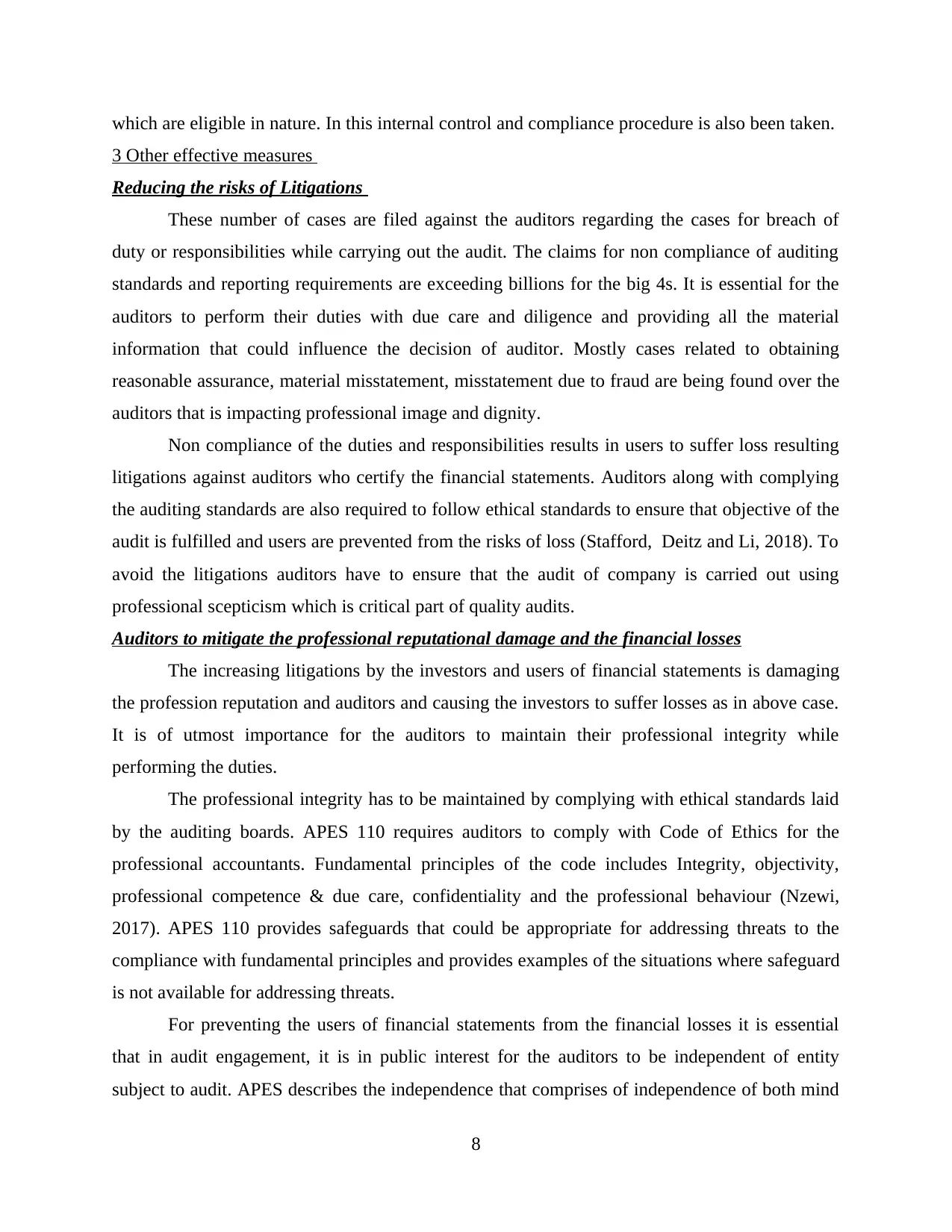
which are eligible in nature. In this internal control and compliance procedure is also been taken.
3 Other effective measures
Reducing the risks of Litigations
These number of cases are filed against the auditors regarding the cases for breach of
duty or responsibilities while carrying out the audit. The claims for non compliance of auditing
standards and reporting requirements are exceeding billions for the big 4s. It is essential for the
auditors to perform their duties with due care and diligence and providing all the material
information that could influence the decision of auditor. Mostly cases related to obtaining
reasonable assurance, material misstatement, misstatement due to fraud are being found over the
auditors that is impacting professional image and dignity.
Non compliance of the duties and responsibilities results in users to suffer loss resulting
litigations against auditors who certify the financial statements. Auditors along with complying
the auditing standards are also required to follow ethical standards to ensure that objective of the
audit is fulfilled and users are prevented from the risks of loss (Stafford, Deitz and Li, 2018). To
avoid the litigations auditors have to ensure that the audit of company is carried out using
professional scepticism which is critical part of quality audits.
Auditors to mitigate the professional reputational damage and the financial losses
The increasing litigations by the investors and users of financial statements is damaging
the profession reputation and auditors and causing the investors to suffer losses as in above case.
It is of utmost importance for the auditors to maintain their professional integrity while
performing the duties.
The professional integrity has to be maintained by complying with ethical standards laid
by the auditing boards. APES 110 requires auditors to comply with Code of Ethics for the
professional accountants. Fundamental principles of the code includes Integrity, objectivity,
professional competence & due care, confidentiality and the professional behaviour (Nzewi,
2017). APES 110 provides safeguards that could be appropriate for addressing threats to the
compliance with fundamental principles and provides examples of the situations where safeguard
is not available for addressing threats.
For preventing the users of financial statements from the financial losses it is essential
that in audit engagement, it is in public interest for the auditors to be independent of entity
subject to audit. APES describes the independence that comprises of independence of both mind
8
3 Other effective measures
Reducing the risks of Litigations
These number of cases are filed against the auditors regarding the cases for breach of
duty or responsibilities while carrying out the audit. The claims for non compliance of auditing
standards and reporting requirements are exceeding billions for the big 4s. It is essential for the
auditors to perform their duties with due care and diligence and providing all the material
information that could influence the decision of auditor. Mostly cases related to obtaining
reasonable assurance, material misstatement, misstatement due to fraud are being found over the
auditors that is impacting professional image and dignity.
Non compliance of the duties and responsibilities results in users to suffer loss resulting
litigations against auditors who certify the financial statements. Auditors along with complying
the auditing standards are also required to follow ethical standards to ensure that objective of the
audit is fulfilled and users are prevented from the risks of loss (Stafford, Deitz and Li, 2018). To
avoid the litigations auditors have to ensure that the audit of company is carried out using
professional scepticism which is critical part of quality audits.
Auditors to mitigate the professional reputational damage and the financial losses
The increasing litigations by the investors and users of financial statements is damaging
the profession reputation and auditors and causing the investors to suffer losses as in above case.
It is of utmost importance for the auditors to maintain their professional integrity while
performing the duties.
The professional integrity has to be maintained by complying with ethical standards laid
by the auditing boards. APES 110 requires auditors to comply with Code of Ethics for the
professional accountants. Fundamental principles of the code includes Integrity, objectivity,
professional competence & due care, confidentiality and the professional behaviour (Nzewi,
2017). APES 110 provides safeguards that could be appropriate for addressing threats to the
compliance with fundamental principles and provides examples of the situations where safeguard
is not available for addressing threats.
For preventing the users of financial statements from the financial losses it is essential
that in audit engagement, it is in public interest for the auditors to be independent of entity
subject to audit. APES describes the independence that comprises of independence of both mind
8
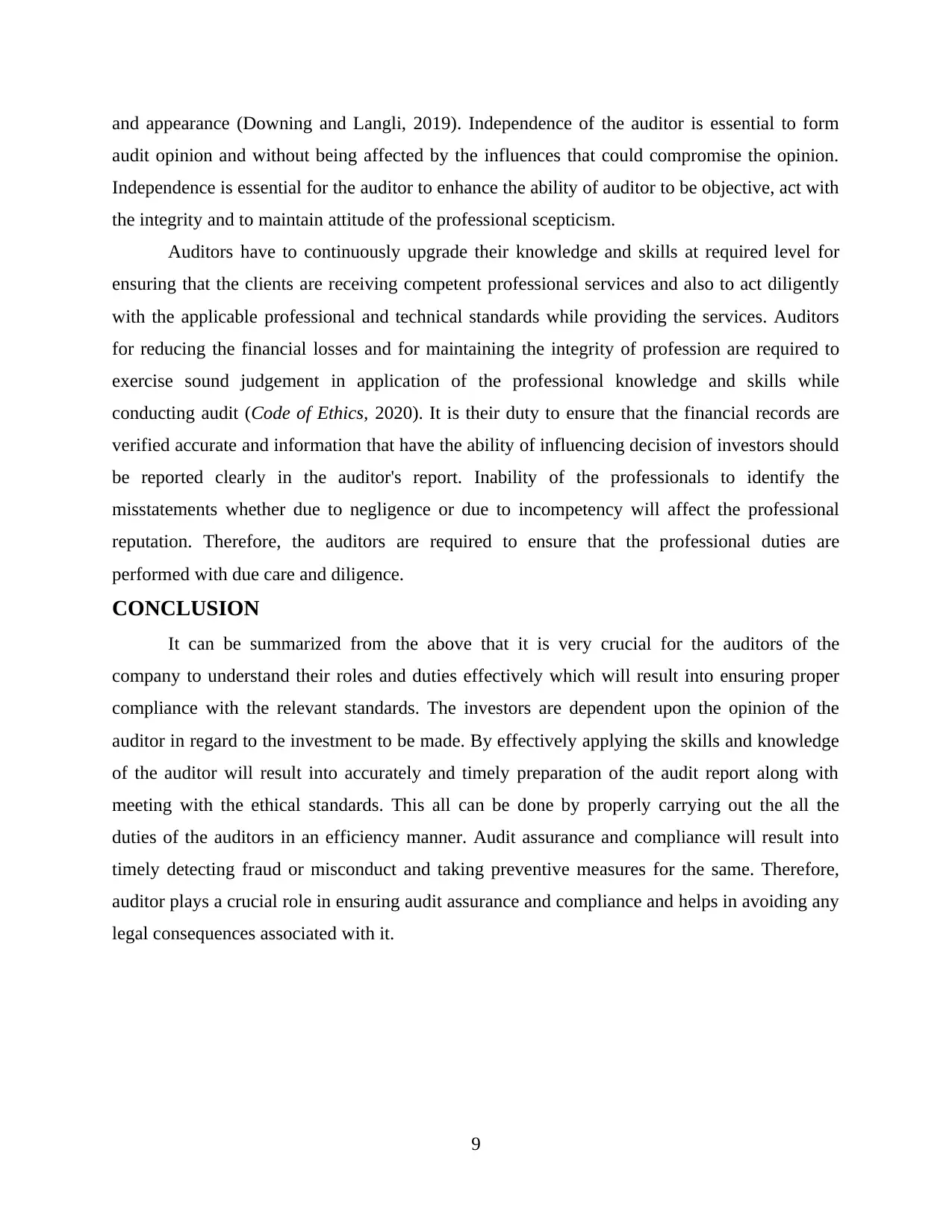
and appearance (Downing and Langli, 2019). Independence of the auditor is essential to form
audit opinion and without being affected by the influences that could compromise the opinion.
Independence is essential for the auditor to enhance the ability of auditor to be objective, act with
the integrity and to maintain attitude of the professional scepticism.
Auditors have to continuously upgrade their knowledge and skills at required level for
ensuring that the clients are receiving competent professional services and also to act diligently
with the applicable professional and technical standards while providing the services. Auditors
for reducing the financial losses and for maintaining the integrity of profession are required to
exercise sound judgement in application of the professional knowledge and skills while
conducting audit (Code of Ethics, 2020). It is their duty to ensure that the financial records are
verified accurate and information that have the ability of influencing decision of investors should
be reported clearly in the auditor's report. Inability of the professionals to identify the
misstatements whether due to negligence or due to incompetency will affect the professional
reputation. Therefore, the auditors are required to ensure that the professional duties are
performed with due care and diligence.
CONCLUSION
It can be summarized from the above that it is very crucial for the auditors of the
company to understand their roles and duties effectively which will result into ensuring proper
compliance with the relevant standards. The investors are dependent upon the opinion of the
auditor in regard to the investment to be made. By effectively applying the skills and knowledge
of the auditor will result into accurately and timely preparation of the audit report along with
meeting with the ethical standards. This all can be done by properly carrying out the all the
duties of the auditors in an efficiency manner. Audit assurance and compliance will result into
timely detecting fraud or misconduct and taking preventive measures for the same. Therefore,
auditor plays a crucial role in ensuring audit assurance and compliance and helps in avoiding any
legal consequences associated with it.
9
audit opinion and without being affected by the influences that could compromise the opinion.
Independence is essential for the auditor to enhance the ability of auditor to be objective, act with
the integrity and to maintain attitude of the professional scepticism.
Auditors have to continuously upgrade their knowledge and skills at required level for
ensuring that the clients are receiving competent professional services and also to act diligently
with the applicable professional and technical standards while providing the services. Auditors
for reducing the financial losses and for maintaining the integrity of profession are required to
exercise sound judgement in application of the professional knowledge and skills while
conducting audit (Code of Ethics, 2020). It is their duty to ensure that the financial records are
verified accurate and information that have the ability of influencing decision of investors should
be reported clearly in the auditor's report. Inability of the professionals to identify the
misstatements whether due to negligence or due to incompetency will affect the professional
reputation. Therefore, the auditors are required to ensure that the professional duties are
performed with due care and diligence.
CONCLUSION
It can be summarized from the above that it is very crucial for the auditors of the
company to understand their roles and duties effectively which will result into ensuring proper
compliance with the relevant standards. The investors are dependent upon the opinion of the
auditor in regard to the investment to be made. By effectively applying the skills and knowledge
of the auditor will result into accurately and timely preparation of the audit report along with
meeting with the ethical standards. This all can be done by properly carrying out the all the
duties of the auditors in an efficiency manner. Audit assurance and compliance will result into
timely detecting fraud or misconduct and taking preventive measures for the same. Therefore,
auditor plays a crucial role in ensuring audit assurance and compliance and helps in avoiding any
legal consequences associated with it.
9
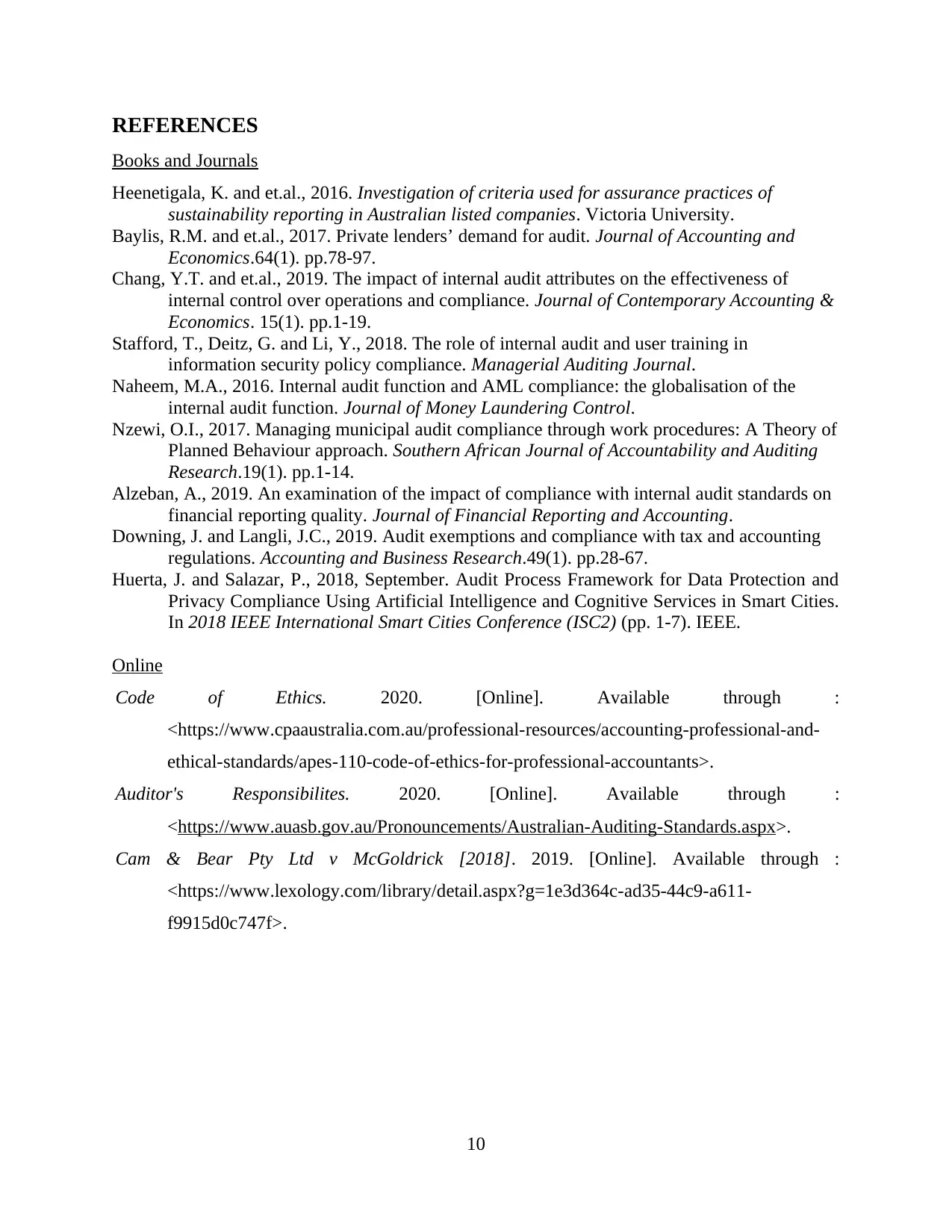
REFERENCES
Books and Journals
Heenetigala, K. and et.al., 2016. Investigation of criteria used for assurance practices of
sustainability reporting in Australian listed companies. Victoria University.
Baylis, R.M. and et.al., 2017. Private lenders’ demand for audit. Journal of Accounting and
Economics.64(1). pp.78-97.
Chang, Y.T. and et.al., 2019. The impact of internal audit attributes on the effectiveness of
internal control over operations and compliance. Journal of Contemporary Accounting &
Economics. 15(1). pp.1-19.
Stafford, T., Deitz, G. and Li, Y., 2018. The role of internal audit and user training in
information security policy compliance. Managerial Auditing Journal.
Naheem, M.A., 2016. Internal audit function and AML compliance: the globalisation of the
internal audit function. Journal of Money Laundering Control.
Nzewi, O.I., 2017. Managing municipal audit compliance through work procedures: A Theory of
Planned Behaviour approach. Southern African Journal of Accountability and Auditing
Research.19(1). pp.1-14.
Alzeban, A., 2019. An examination of the impact of compliance with internal audit standards on
financial reporting quality. Journal of Financial Reporting and Accounting.
Downing, J. and Langli, J.C., 2019. Audit exemptions and compliance with tax and accounting
regulations. Accounting and Business Research.49(1). pp.28-67.
Huerta, J. and Salazar, P., 2018, September. Audit Process Framework for Data Protection and
Privacy Compliance Using Artificial Intelligence and Cognitive Services in Smart Cities.
In 2018 IEEE International Smart Cities Conference (ISC2) (pp. 1-7). IEEE.
Online
Code of Ethics. 2020. [Online]. Available through :
<https://www.cpaaustralia.com.au/professional-resources/accounting-professional-and-
ethical-standards/apes-110-code-of-ethics-for-professional-accountants>.
Auditor's Responsibilites. 2020. [Online]. Available through :
<https://www.auasb.gov.au/Pronouncements/Australian-Auditing-Standards.aspx>.
Cam & Bear Pty Ltd v McGoldrick [2018]. 2019. [Online]. Available through :
<https://www.lexology.com/library/detail.aspx?g=1e3d364c-ad35-44c9-a611-
f9915d0c747f>.
10
Books and Journals
Heenetigala, K. and et.al., 2016. Investigation of criteria used for assurance practices of
sustainability reporting in Australian listed companies. Victoria University.
Baylis, R.M. and et.al., 2017. Private lenders’ demand for audit. Journal of Accounting and
Economics.64(1). pp.78-97.
Chang, Y.T. and et.al., 2019. The impact of internal audit attributes on the effectiveness of
internal control over operations and compliance. Journal of Contemporary Accounting &
Economics. 15(1). pp.1-19.
Stafford, T., Deitz, G. and Li, Y., 2018. The role of internal audit and user training in
information security policy compliance. Managerial Auditing Journal.
Naheem, M.A., 2016. Internal audit function and AML compliance: the globalisation of the
internal audit function. Journal of Money Laundering Control.
Nzewi, O.I., 2017. Managing municipal audit compliance through work procedures: A Theory of
Planned Behaviour approach. Southern African Journal of Accountability and Auditing
Research.19(1). pp.1-14.
Alzeban, A., 2019. An examination of the impact of compliance with internal audit standards on
financial reporting quality. Journal of Financial Reporting and Accounting.
Downing, J. and Langli, J.C., 2019. Audit exemptions and compliance with tax and accounting
regulations. Accounting and Business Research.49(1). pp.28-67.
Huerta, J. and Salazar, P., 2018, September. Audit Process Framework for Data Protection and
Privacy Compliance Using Artificial Intelligence and Cognitive Services in Smart Cities.
In 2018 IEEE International Smart Cities Conference (ISC2) (pp. 1-7). IEEE.
Online
Code of Ethics. 2020. [Online]. Available through :
<https://www.cpaaustralia.com.au/professional-resources/accounting-professional-and-
ethical-standards/apes-110-code-of-ethics-for-professional-accountants>.
Auditor's Responsibilites. 2020. [Online]. Available through :
<https://www.auasb.gov.au/Pronouncements/Australian-Auditing-Standards.aspx>.
Cam & Bear Pty Ltd v McGoldrick [2018]. 2019. [Online]. Available through :
<https://www.lexology.com/library/detail.aspx?g=1e3d364c-ad35-44c9-a611-
f9915d0c747f>.
10
1 out of 13
Your All-in-One AI-Powered Toolkit for Academic Success.
+13062052269
info@desklib.com
Available 24*7 on WhatsApp / Email
![[object Object]](/_next/static/media/star-bottom.7253800d.svg)
Unlock your academic potential
© 2024 | Zucol Services PVT LTD | All rights reserved.





